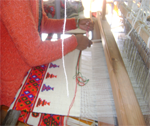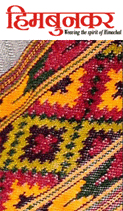Handloom Sector
 The Handlooms Sector is the second largest employer in India, providing employment to about 65 lakh persons. The sector represents the continuity of the age-old Indian heritage of hand weaving and reflects the socio-cultural tradition of the weaving communities. The Government of India has been following a policy of promoting and encouraging the handloom sector through a number of policies and programmes. Most of the schematic interventions of the Government of India in the Ninth and Tenth Plan period have been through the State Agencies and Cooperatives in the Handloom Sector. However, in the face of growing competitiveness in the textile industry both in the national and international markets and the free trade opportunities emerging in the post MFA environment, a growing need has been felt for adopting a focused yet flexible and holistic approach in the sector to facilitate handloom weavers to meet the challenges of a globalize environment. A need has also been felt to empower weavers to chart out a sustainable path for growth and diversification in line with the emerging market trends. The Integrated Handlooms Development Scheme (IHDS) is an attempt to facilitate the sustainable development of handloom weavers located in and outside identified handloom clusters into a cohesive, self- managing and competitive socio-economic unit.
The Handlooms Sector is the second largest employer in India, providing employment to about 65 lakh persons. The sector represents the continuity of the age-old Indian heritage of hand weaving and reflects the socio-cultural tradition of the weaving communities. The Government of India has been following a policy of promoting and encouraging the handloom sector through a number of policies and programmes. Most of the schematic interventions of the Government of India in the Ninth and Tenth Plan period have been through the State Agencies and Cooperatives in the Handloom Sector. However, in the face of growing competitiveness in the textile industry both in the national and international markets and the free trade opportunities emerging in the post MFA environment, a growing need has been felt for adopting a focused yet flexible and holistic approach in the sector to facilitate handloom weavers to meet the challenges of a globalize environment. A need has also been felt to empower weavers to chart out a sustainable path for growth and diversification in line with the emerging market trends. The Integrated Handlooms Development Scheme (IHDS) is an attempt to facilitate the sustainable development of handloom weavers located in and outside identified handloom clusters into a cohesive, self- managing and competitive socio-economic unit.
Integrated Handloom Development Scheme (IHDS)
 Integrated Handlooms Development Scheme (IHDS) to be implemented during the XI Plan has been formulated as a Centrally Sponsored Plan Scheme by merging the essential components, with or without modifications, of the four schemes i.e. Deen Dayal Hathkargha Protsahan Yojana (DDHPY), Integrated Handloom Training Project (IHTP), Integrated Handloom Cluster Development Scheme (IHCDS) and Workshed-cum-Housing Scheme, implemented during the 10th Plan.
Integrated Handlooms Development Scheme (IHDS) to be implemented during the XI Plan has been formulated as a Centrally Sponsored Plan Scheme by merging the essential components, with or without modifications, of the four schemes i.e. Deen Dayal Hathkargha Protsahan Yojana (DDHPY), Integrated Handloom Training Project (IHTP), Integrated Handloom Cluster Development Scheme (IHCDS) and Workshed-cum-Housing Scheme, implemented during the 10th Plan.
OBJECTIVES OF THE SCHEME
• To focus on formation of handloom weavers’ groups as a visible production group in a selected handloom clusters.
• To assist the handloom Weavers Groups for becoming self –sustainable,
• An inclusive approach to cover weavers both within and outside the Co-operative fold,
• To up-grade the skills of handloom weavers/workers to produce diversified products with improved quality to meet the market requirements,
• To provide suitable workplace to weavers to enable them to produce quality products with improved productivity,
• Market orientation by associating entrepreneurs, designers and professionals for marketing, designing and managing the production,
• To facilitate process of credit from financial institutions/banks.
• To encourage co-operativisation of weavers.
• Holistic and flexible interventions to provide need based inputs specific to each cluster/group.

